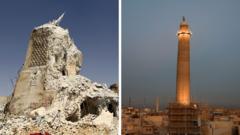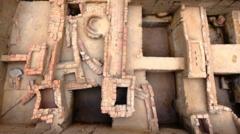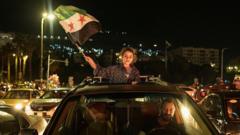Following years of destruction during the Islamic State's (IS) occupation, the Iraqi city of Mosul is witnessing a renaissance as historic landmarks are being restored and reopened to the community. The reconstruction project, spearheaded and financed by UNESCO, began just a year after IS was ousted from the city in 2017. Wednesday marked a significant milestone, with UNESCO director-general Audrey Azoulay attending a celebratory ceremony that highlighted the revival of Mosul's rich heritage.
Once a vibrant symbol of coexistence among diverse religious and ethnic groups, Mosul fell to IS in 2014, a time when tolerance and unity were forcefully shattered. The extremist group instilled a climate of fear by targeting minorities and brutally suppressing dissent. However, after three arduous years marked by a fierce military campaign led by a US-backed coalition, IS was expelled from Mosul, leaving behind a trail of devastation, particularly in the Old City where most of the destruction occurred.
Local photographer Ali al-Baroodi recalls the haunting aftermath of the liberation as he entered Mosul for the first time post-battle in the summer of 2017. He described the scene as ghostly, where beloved landmarks like the al-Hadba minaret, twisted by war, stood in ruins against a skyline forever altered. "It was like a metamorphosis that we never imagined," he said, reflecting on the horror and loss that lingered.
Despite the challenges, efforts to rebuild initiated under UNESCO have begun to take shape, with an allocated budget of $115 million, supported largely by the United Arab Emirates and European Union. Father Olivier Poquillon, a Dominican priest, has been actively involved in restoring the centuries-old convent of Notre-Dame de l'Heure, emphasizing the importance of fostering trust among the diverse communities. "Rebuilding trust is crucial because the buildings alone cannot heal the wounds," he stated.
At the helm of this vast restoration effort is chief architect Maria Rita Acetoso, who believes in the project’s potential to create jobs and empower local youth. Through skilled training programs, over 1,300 young people have been educated in traditional crafts, while thousands of new job opportunities have emerged. "Restoration is not just about walls; it's about restoring cultural identity," she explained.
As the bells of al-Tahera Church ring out again, signaling the rebirth of community spirit, families are slowly returning to homes that are deeply intertwined with their history. Residents like Mustafa and Abdullah share their emotional journeys of returning to their rebuilt homes, which carry legacies of their ancestors.
While the scars from Mosul's turbulent past may never fully fade, the regeneration of the Old City and its landmarks heralds a glimmer of hope for a brighter future. As Ali al-Baroodi continues to capture the transformation of his beloved city, he poignantly concludes that witnessing this revival is akin to watching a dead person come back to life, symbolizing the resilience and enduring spirit of the people of Mosul.
Once a vibrant symbol of coexistence among diverse religious and ethnic groups, Mosul fell to IS in 2014, a time when tolerance and unity were forcefully shattered. The extremist group instilled a climate of fear by targeting minorities and brutally suppressing dissent. However, after three arduous years marked by a fierce military campaign led by a US-backed coalition, IS was expelled from Mosul, leaving behind a trail of devastation, particularly in the Old City where most of the destruction occurred.
Local photographer Ali al-Baroodi recalls the haunting aftermath of the liberation as he entered Mosul for the first time post-battle in the summer of 2017. He described the scene as ghostly, where beloved landmarks like the al-Hadba minaret, twisted by war, stood in ruins against a skyline forever altered. "It was like a metamorphosis that we never imagined," he said, reflecting on the horror and loss that lingered.
Despite the challenges, efforts to rebuild initiated under UNESCO have begun to take shape, with an allocated budget of $115 million, supported largely by the United Arab Emirates and European Union. Father Olivier Poquillon, a Dominican priest, has been actively involved in restoring the centuries-old convent of Notre-Dame de l'Heure, emphasizing the importance of fostering trust among the diverse communities. "Rebuilding trust is crucial because the buildings alone cannot heal the wounds," he stated.
At the helm of this vast restoration effort is chief architect Maria Rita Acetoso, who believes in the project’s potential to create jobs and empower local youth. Through skilled training programs, over 1,300 young people have been educated in traditional crafts, while thousands of new job opportunities have emerged. "Restoration is not just about walls; it's about restoring cultural identity," she explained.
As the bells of al-Tahera Church ring out again, signaling the rebirth of community spirit, families are slowly returning to homes that are deeply intertwined with their history. Residents like Mustafa and Abdullah share their emotional journeys of returning to their rebuilt homes, which carry legacies of their ancestors.
While the scars from Mosul's turbulent past may never fully fade, the regeneration of the Old City and its landmarks heralds a glimmer of hope for a brighter future. As Ali al-Baroodi continues to capture the transformation of his beloved city, he poignantly concludes that witnessing this revival is akin to watching a dead person come back to life, symbolizing the resilience and enduring spirit of the people of Mosul.





















